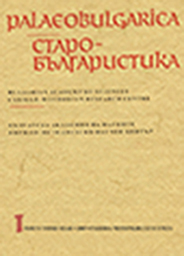Проблемът за преводите на старобългарски и старосръбски текстове на полски език
Translating Old Bulgarian and Old Serbian Texts into Polish
Author(s): Izabela Lis-WielgoszSubject(s): Language studies, Language and Literature Studies
Published by: Кирило-Методиевски научен център при Българска академия на науките
Summary/Abstract: In the article, a problem of translation of the Old Bulgarian and Old Serbian literary texts to Polish is discussed together with the basic mechanisms of the reception process of creativity revealed by the Orthodox Slavs from the Balkan region that is in other words, the works arisen in the circle of the Slavia Orthodoxa and their presence in the Polish culture’s space which belongd to circle of the Slavia Latina. The considerations regard the essence and function of translation, presence and absence of translated literature – its initial version in the target space, and their foundation is located in the collections of translations existing in the Polish reading circuit. The issue of the presence or position of the Old South Slavonic literatures namely, the Old Bulgarian and Old Serbian texts in their Polish translation, is featured in several possible perspectives. The problem is exposed in the aspect of these texts’ peripheral character, literary genetics, and paratextuality. By dint of the first reference, a phenomenon of asymmetry in the realm of translated literatures is emphasized which results from the domination of the so-called world literatures and the marginalization of the so-called small literatures along with the translated literary texts’ place – their initial (Church Slavonic) status from the view-point of the target (Polish) culture’s space, and their situation in this specific polysystem. The genetic studies’ path, however, is used in order to expose a form of the translated literature’s presence (Old Bulgarian and Old Serbian texts in their Polish translation), and to indicate the strategy of its introduction namely, anthology as a supporting platform of the initial (source) literature in the space of the target culture together with its presentation, dialogical, and intercultural function derived from the authorized genre. Eventually the paratextual suggestion enables to cast some light on the key role of the so-called cover namely, periphrasis in the process of reception as well as projection, and to manifest the translator’s actions along with the whole collection of the translated works in order to externalize a specific strategy which consists in the translator’s mission and position. It is, therefore, worth recalling that the author of any translation might act as a bridgehead, negotiator and promoter who is to bring together the both cultural spaces in the singular translation event. In the article’s conclusion, the authoress accentuates the fact that the collections or individual publications of the Old Bulgarian and Old Serbian works, omitting various values of the particular projects and realizations, exist in the Polish reading circuit in order to reflect largely their presence status, knowledge, and need for those concrete South Slavonic literatures. The repeatedly sketched suppositions as for their abeyance, exotic character and perceptive difficulties are ipso facto confirmed. Also, the positive although slow transformations of the process of the Old Bulgarian and Old Serbian works’ reception in Poland are highlighted which result above all from many initiatives concerning the Church Slavonic works’ translation to Polish realized in recent years and equipping their representation in the dense paratextual cover, etc.
Journal: PALAEOBULGARICA / СТАРОБЪЛГАРИСТИКА
- Issue Year: 2019
- Issue No: 1
- Page Range: 62-80
- Page Count: 19
- Language: Bulgarian
- Content File-PDF

